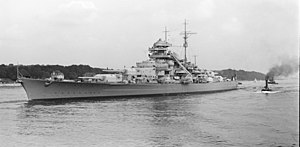German battleship Bismarck

Bismarck in 1940
|
|
| History | |
|---|---|
|
|
|
| Name: | Bismarck |
| Namesake: | Otto von Bismarck |
| Builder: | Blohm & Voss, Hamburg |
| Laid down: | 1 July 1936 |
| Launched: | 14 February 1939 |
| Commissioned: | 24 August 1940 |
| Honors and awards: |
3 times mentioned in the Wehrmachtbericht |
| Fate: |
|
| Badge: | |
| General characteristics | |
| Class and type: | Bismarck-class battleship |
| Displacement: | |
| Length: | |
| Beam: | 36 m (118 ft 1 in) |
| Draft: | 9.3 m (30 ft 6 in) standard |
| Propulsion: | |
| Speed: | 30.01 knots (55.58 km/h; 34.53 mph) during trials |
| Range: | 8,870 nmi (16,430 km; 10,210 mi) at 19 knots (35 km/h; 22 mph) |
| Complement: |
|
| Armament: |
|
| Armour: |
|
| Aircraft carried: | 4 × Arado Ar 196 floatplanes |
| Aviation facilities: | 1 double-ended catapult |
Bismarck was the first of two Bismarck-class battleships built for Nazi Germany's Kriegsmarine. Named after Chancellor Otto von Bismarck, the primary force behind the unification of Germany in 1871, the ship was laid down at the Blohm & Voss shipyard in Hamburg in July 1936 and launched in February 1939. Work was completed in August 1940, when she was commissioned into the German fleet. Bismarck and her sister ship Tirpitz were the largest battleships ever built by Germany, and two of the largest built by any European power.
In the course of the warship's eight-month career under its sole commanding officer, Captain Ernst Lindemann, Bismarck conducted only one offensive operation, in May 1941, codenamed Rheinübung. The ship, along with the heavy cruiser Prinz Eugen, was to break into the Atlantic Ocean and raid Allied shipping from North America to Great Britain. The two ships were detected several times off Scandinavia, and British naval units were deployed to block their route. At the Battle of the Denmark Strait, Bismarck engaged and destroyed the battlecruiser HMS Hood, the pride of the Royal Navy, and forced the battleship HMS Prince of Wales to retreat; Bismarck was hit three times and suffered an oil leak from a ruptured tank.
The destruction of Hood spurred a relentless pursuit by the Royal Navy involving dozens of warships. Two days later, heading for the relative safety of occupied France, Bismarck was attacked by obsolescent Fairey Swordfish biplane torpedo bombers from the aircraft carrier HMS Ark Royal; one scored a hit that rendered the battleship's steering gear inoperable. In her final battle the following morning, Bismarck was neutralised by a sustained bombardment from a British fleet, was scuttled by her crew, and sank with heavy loss of life. Most experts agree that the battle damage would have caused her to sink eventually. The wreck was located in June 1989 by Robert Ballard, and has since been further surveyed by several other expeditions.
...
Wikipedia

